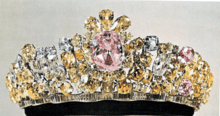Noor-ul-Ain
The Noor-ul-Ain (Arabic: نور العين, lit. 'the light of the eye') is one of the largest pink diamonds in the world, and the centre piece of the tiara of the same name.
 The Noor-ul-Ain mounted in a tiara of the same name | |
| Weight | Around 60 carats (12 g) |
|---|---|
| Color | Pale Pink |
| Cut | Oval Brilliant |
| Country of origin | India |
| Mine of origin | Golconda |
| Original owner | Mughal |
| Owner | Iranian Crown Jewels[1] |
History
The diamond is believed to have been recovered from the Vijayanagara mines in India and was brought into the Iranian Imperial collection after Persian king Nader Shah Afshar looted Delhi in the 18th century.
The Noor-ul-Ain is believed to have once formed part of an even larger gem called the Great Table diamond. That larger diamond is thought to have been cut in two, with one section becoming the Noor-ul-Ain and the other the Daria-i-Noor diamond. Both of these pieces are currently part of the Iranian Crown Jewels.[1]
History of the tiara
The Noor-ul-Ain is the principal diamond mounted in a tiara of the same name made for Iranian Empress Farah Pahlavi's wedding to Shah Mohammad Reza Pahlavi in 1958. The tiara was designed by Harry Winston. It is a modern design, featuring 324 pink, yellow, and white diamonds set in platinum. It is said to weigh around 2 kg (4.4 lb). The tiara forms part of the Iranian crown jewels, held at the National Treasury of Iran in the Central Bank in Tehran.[2]
It is a Type IIa diamond.[3]
See also
- Great Table diamond
- Koh-i-Noor diamond
- List of diamonds
- List of largest rough diamonds
- Elizabeth II's jewels
References
Anna Malecka, "The Mystery of the Nur al-Ayn Diamond", Gems & Jewellery: The Gemmological Association of Great Britain, volume 23 (7), August/September 2014, pp. 20-22;